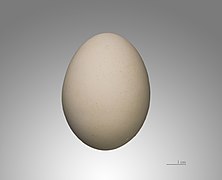Abdim's stork
| Abdim's stork | |
|---|---|
| At the London Zoo, England | |
| Scientific classification | |
| Kingdom: | Animalia |
| Phylum: | Chordata |
| Class: | Aves |
| Order: | Ciconiiformes |
| Family: | Ciconiidae |
| Genus: | Ciconia |
| Species: | C. abdimii
|
| Binomial name | |
| Ciconia abdimii Lichtenstein, 1823
| |
Abdim's stork (Ciconia abdimii), also known as the white-bellied stork, is a stork belonging to the family Ciconiidae. The common name commemorates the Turkish Governor of Wadi Halfa in Sudan, (1780–1827).[2]
Distribution and habitat[]
Abdim's stork is found in open habitats throughout Eastern Africa, from Ethiopia south to South Africa. This stork has escaped or been deliberately released into Florida, U.S., but there is no evidence that the population is breeding and may only persist due to continuing releases or escapes.[1]
Widespread and common throughout its large range, Abdim's stork is evaluated as Least Concern on the IUCN Red List of Threatened Species.[1] It is the subject of several nationally coordinated breeding programs: in the United States, the plan for this species is administered by the Association of Zoos and Aquariums and in Europe by the European Association of Zoos and Aquaria.
Description[]
Ciconia abdimii is a black stork with grey legs, red knees and feet, grey bill and white underparts. It has red facial skin in front of the eye and blue skin near the bill in breeding season. It is the smallest species of stork, at 73 cm (29 in) and a weight of just over 1 kg (2.2 lb).[3]
Biology[]
Ciconia abdimii feeds mainly of locusts, caterpillars and other large insects, although these birds will also eat small reptiles, amphibians, mice, crabs and eggs.[2] The female lays two to three eggs and is slightly smaller than the male.
Human culture[]
Among the smallest storks, this species is welcomed and protected by local Africans who believe that it is a harbinger of rain and good luck.
Gallery[]

At the San Diego Zoo

Egg of Ciconia abdimii - Muséum de Toulouse
Ciconia abdimii at Busch Gardens Tampa (video clip).
References[]
- ^ a b BirdLife International (2016). "Ciconia abdimii". IUCN Red List of Threatened Species. 2016: e.T22697673A93629659. doi:10.2305/IUCN.UK.2016-3.RLTS.T22697673A93629659.en. Retrieved 6 September 2021.
- ^ a b ""Abdim's Stork Fact Sheet, Lincoln Park Zoo"". Archived from the original on 2012-08-15. Retrieved 2011-07-08.
- ^ "Abdim's Stork Animal Bytes". SeaWorld. Archived from the original on December 27, 2013. Retrieved December 27, 2013.
External links[]
| Wikispecies has information related to Ciconia abdimii. |
| Wikimedia Commons has media related to: Ciconia abdimii (category) |
- Abdim's Stork Ciconia abdimii - BirdLife International
- Abdim’s Stork - The Atlas of Southern African Birds
- Abdim's Stork - SeaWorld Parks and Entertainment
- IUCN Red List least concern species
- Ciconia
- Birds of Sub-Saharan Africa
- Birds of the Middle East
- Birds described in 1823


